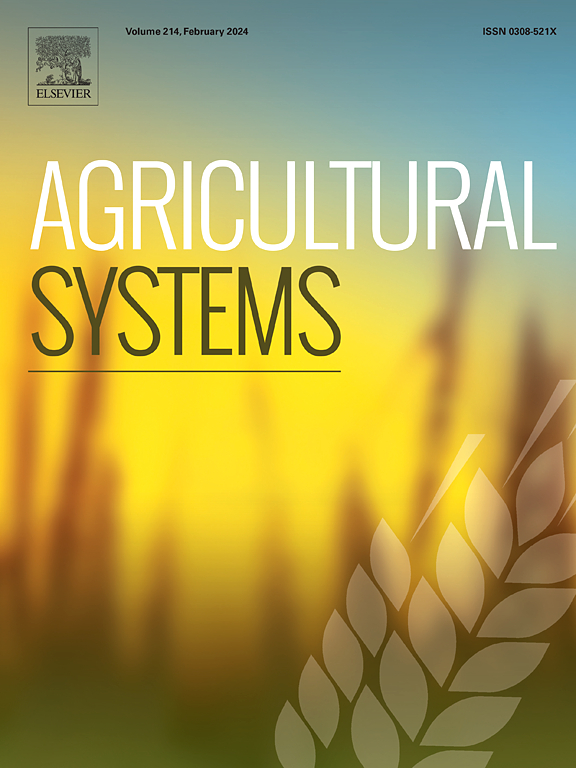Development of ReturN, a manure redistribution optimisation tool: Description and application context
IF 6.1
1区 农林科学
Q1 AGRICULTURE, MULTIDISCIPLINARY
引用次数: 0
Abstract
CONTEXT
Collaborative agreements for manure management would enable intensive and specialized livestock farms to expand the agricultural area available for manure distribution by transporting manure to arable farms, thus increasing nitrogen and carbon recycling, reducing environmental pollution and decreasing farms' dependence on external inputs. The economic and environmental viability of such collaborative arrangements depends on the balance between the manure transport costs and emissions (and thus the distances between farms) and the saving in mineral fertiliser purchase costs and production emissions.
OBJECTIVE
The objective of this study is to present a software tool (ReturN) designed to assess the opportunities for moving he nitrogen (N) in manure from locations where the amount exceeds the utilization capacity of the crops to locations with spare utilization capacity. ReturN allows the optimisation of manure fluxes at a local or regional scale, on the basis of a multi-criteria balance that considers both economic and environmental criteria. The tool is applied in three European case studies thus showcasing the tool applicability options.
METHODS
The ReturN multi-criteria balance considers manure transport costs and emissions (and thus the distances between source and recipient locations) and the saving in mineral N fertiliser purchase costs and production emissions. The locations among which manure-N fluxes are optimised can be farms or municipalities, based on the aggregation level of the manure data. The tool outputs, linked to each flux of manure from a source to a recipient location, are the amount of transported N, the monetary costs, and the associated fossil carbon dioxide (CO2) emissions. The ReturN tool was applied to the optimisation of manure fluxes in 3 real European case studies, and the sensitivity of its outputs to parameters was assessed using the modified Morris sensitivity analysis method.
RESULTS AND CONCLUSIONS
The application of the ReturN tool successfully optimised manure-N redistribution under varying conditions of deficits and surpluses and for different geographical areas shapes. The reduction in costs associated with the purchase of mineral N fertilisers and the decrease in fossil CO2 emissions (due to the transportation of manure and the production of mineral N fertilisers) achieved through the optimisation of manure-N fluxes were found to be primarily dependent on the initial manure surplus condition and secondly on mineral N fertiliser price and manure characteristics (density and N concentration).
SIGNIFICANCE
The flexibility of the ReturN tool's settings, along with its limited input requirements, ensures its suitability for direct application by end users in practical contexts thus enabling both the economic and environmental assessment of the cost-effectiveness of manure transport.

粪肥再分配优化工具ReturN的开发:描述和应用背景
内容提要粪肥管理合作协议将使集约化和专业化畜牧场能够通过将粪肥运输到耕地农场来扩大可用于粪肥分配的农业面积,从而增加氮和碳的循环利用、减少环境污染并降低农场对外部投入的依赖性。这种合作安排的经济和环境可行性取决于粪肥运输成本和排放量(以及农场之间的距离)与节省的矿物肥料购买成本和生产排放之间的平衡。本研究的目的是介绍一种软件工具(ReturN),旨在评估将粪肥中的氮素(N)从超过作物利用能力的地方转移到有剩余利用能力的地方的机会。ReturN 允许在考虑经济和环境标准的多标准平衡基础上,在地方或区域范围内优化粪肥流量。ReturN 的多标准平衡考虑了粪肥运输成本和排放(以及来源地和接收地之间的距离),以及节省的矿物氮肥购买成本和生产排放。根据粪肥数据的汇总级别,粪肥-氮通量的优化地点可以是农场或城市。该工具的输出结果与粪肥从来源地到接收地的每一通量相关联,包括氮的运输量、货币成本以及相关的化石二氧化碳 (CO2) 排放量。ReturN 工具被应用于 3 个实际欧洲案例研究中的粪肥流量优化,并使用修改后的莫里斯敏感性分析方法评估了其输出对参数的敏感性。通过优化粪肥-氮通量,降低了与购买矿物氮肥相关的成本,减少了化石二氧化碳排放量(由于运输粪肥和生产矿物氮肥),这主要取决于初始粪肥过剩条件,其次取决于矿物氮肥价格和粪肥特性(密度和氮浓度)。意义ReturN 工具设置的灵活性及其有限的输入要求确保其适合最终用户在实际环境中直接应用,从而能够对粪肥运输的成本效益进行经济和环境评估。
本文章由计算机程序翻译,如有差异,请以英文原文为准。
求助全文
约1分钟内获得全文
求助全文
来源期刊

Agricultural Systems
农林科学-农业综合
CiteScore
13.30
自引率
7.60%
发文量
174
审稿时长
30 days
期刊介绍:
Agricultural Systems is an international journal that deals with interactions - among the components of agricultural systems, among hierarchical levels of agricultural systems, between agricultural and other land use systems, and between agricultural systems and their natural, social and economic environments.
The scope includes the development and application of systems analysis methodologies in the following areas:
Systems approaches in the sustainable intensification of agriculture; pathways for sustainable intensification; crop-livestock integration; farm-level resource allocation; quantification of benefits and trade-offs at farm to landscape levels; integrative, participatory and dynamic modelling approaches for qualitative and quantitative assessments of agricultural systems and decision making;
The interactions between agricultural and non-agricultural landscapes; the multiple services of agricultural systems; food security and the environment;
Global change and adaptation science; transformational adaptations as driven by changes in climate, policy, values and attitudes influencing the design of farming systems;
Development and application of farming systems design tools and methods for impact, scenario and case study analysis; managing the complexities of dynamic agricultural systems; innovation systems and multi stakeholder arrangements that support or promote change and (or) inform policy decisions.
 求助内容:
求助内容: 应助结果提醒方式:
应助结果提醒方式:


